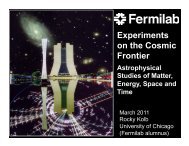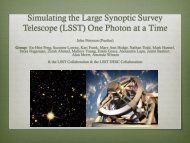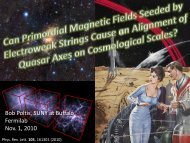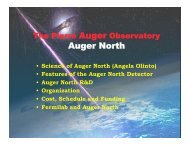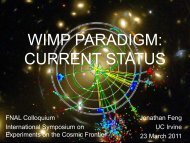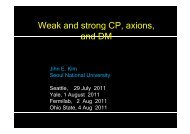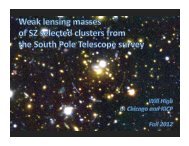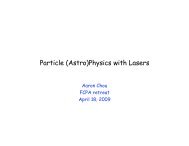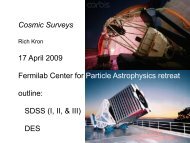Kathy Turner (DOE) - Fermilab Center for Particle Astrophysics
Kathy Turner (DOE) - Fermilab Center for Particle Astrophysics
Kathy Turner (DOE) - Fermilab Center for Particle Astrophysics
You also want an ePaper? Increase the reach of your titles
YUMPU automatically turns print PDFs into web optimized ePapers that Google loves.
Office of High Energy Physics<br />
Program Status<br />
Cosmic Frontier Symposium<br />
March 26, 2011 at <strong>Fermilab</strong><br />
<strong>Kathy</strong> <strong>Turner</strong><br />
Office of High Energy Physics<br />
<strong>DOE</strong> Office of Science
<strong>DOE</strong> Office of High Energy Physics Program<br />
Overall Program & Budgets<br />
The Cosmic Frontier<br />
2
High Energy Physics Program - Scientific Frontiers<br />
The Energy Frontier, powerful accelerators are used<br />
to create new particles, reveal their interactions,<br />
and investigate fundamental <strong>for</strong>ces;<br />
The Intensity Frontier, intense particle beams and<br />
highly sensitive detectors are used to pursue<br />
alternate pathways to investigate fundamental<br />
<strong>for</strong>ces and particle interactions by studying events<br />
that occur rarely in nature; and<br />
The Cosmic Frontier, ground and space-based<br />
experiments and telescopes are used to make<br />
measurements that will offer new insight and<br />
in<strong>for</strong>mation about the nature of dark matter and<br />
dark energy, to understand fundamental particle<br />
properties and discover new phenomena.<br />
The major elements of <strong>DOE</strong>’s plan are to:<br />
Exploit the capabilities of the Tevatron and LHC at the Energy Frontier to make discoveries<br />
Implement a world-class Intensity Frontier program at <strong>Fermilab</strong><br />
Address compelling high-impact scientific opportunities at the Cosmic Frontier<br />
Develop accelerator technologies needed by Nation and <strong>for</strong> a U.S. leadership role in particle<br />
physics<br />
3
FY 2011 – We are in a Continuing Resolution<br />
FY 2010<br />
Actual<br />
FY 2011<br />
Request<br />
FY 2011<br />
CR<br />
HEP 810,483 829,000 799,500<br />
SC 4,789,288 5,129,574 4,826,000<br />
We have been operating under a CR <strong>for</strong> almost 6 full months now.<br />
We are below the FY 2010 level, since funds are being held back <strong>for</strong> new project<br />
starts.<br />
The House just passed another 3 week CR with no change <strong>for</strong> SC.<br />
MicroBooNE, Mu2e, and LBNE are considered new starts and are not receiving<br />
any equipment funding, which includes PED <strong>for</strong> Mu2e and LBNE.<br />
Long Continuing Resolution (again) has delayed funding of current grants and<br />
new grants are on hold.<br />
4
The President’s FY12 Budget Request <strong>for</strong> High Energy Physics<br />
Description FY 2010<br />
FY 2011<br />
Request<br />
FY 2011<br />
March<br />
FY 2012<br />
Request<br />
FY12 vs<br />
FY10<br />
Proton Accelerator-Based<br />
Physics 438,369 439,262 439,462 412,707 -25,662<br />
Electron Accelerator-Based<br />
Physics 30,212 24,707 20,805 22,319 -7,893<br />
Non-Accelerator Physics 97,469 88,539 88,539 81,852 -15,617<br />
Theoretical Physics 68,414 69,524 68,024 68,914 500<br />
Advanced Technology R&D 156,347 189,968 173,346 171,908 15,561<br />
Construction 0 17,000 0 39,500 39,500<br />
Total, High Energy Physics 790,811 829,000 794,078 797,200 6,389<br />
FY 2010 appropriation including SBIR/STTR was $810 million, so the FY<br />
2012 request is a reduction of $13 million from FY 2010.<br />
5
By program<br />
Cross cuts<br />
EPP Research<br />
Technology<br />
Research<br />
Facilities<br />
MIE<br />
By function<br />
Proton<br />
Electron<br />
Non-accelerator<br />
Theory<br />
Advanced Tech<br />
6
5,000<br />
4,500<br />
4,000<br />
3,500<br />
3,000<br />
2,500<br />
2,000<br />
1,500<br />
1,000<br />
500<br />
—<br />
FY 1995<br />
FY 1996<br />
SC and HEP Funding Trends<br />
FY 1997<br />
FY 1998<br />
FY 1999<br />
FY 2000<br />
FY 2001<br />
FY 2002<br />
FY 2003<br />
FY 2004<br />
FY 2005<br />
FY 2006<br />
FY 2007<br />
FY 2008<br />
FY 2009<br />
FY 2010<br />
FY 2011 CR<br />
FY 2011 Request<br />
FY 2012 Request<br />
Rest of SC<br />
HEP<br />
7
850,000<br />
800,000<br />
750,000<br />
700,000<br />
650,000<br />
600,000<br />
FY 1996<br />
FY 1997<br />
FY 1998<br />
HEP Funding History<br />
FY 1999<br />
FY 2000<br />
FY 2001<br />
FY 2002<br />
FY 2003<br />
HEP<br />
FY 2004<br />
FY 2005<br />
FY 2006<br />
FY 2007<br />
FY 2008<br />
FY 2009<br />
FY 2010<br />
FY 2011 CR<br />
FY 2011<br />
FY 2012<br />
HEP<br />
8
70.0%<br />
60.0%<br />
50.0%<br />
40.0%<br />
30.0%<br />
20.0%<br />
10.0%<br />
0.0%<br />
Trading projects <strong>for</strong> more<br />
research<br />
FY 1996<br />
FY 1997<br />
FY 1998<br />
FY 1999<br />
FY 2000<br />
FY 2001<br />
FY 2002<br />
Trends<br />
• In the late 90’s the fraction devoted to projects was about 20%.<br />
• This fraction reached a minimum around 2006.<br />
• The projects started since then are coming to completion.<br />
FY 2003<br />
FY 2004<br />
FY 2005<br />
FY 2006<br />
FY 2007<br />
FY 2008<br />
FY 2009<br />
FY 2010<br />
Ramp up ILC, SRF, and<br />
some accounting<br />
changes.<br />
• The HEP Committee of Visitors recommended projects should be ~20% of<br />
the budget.<br />
FY 2011<br />
FY 2012<br />
Research<br />
Facilities<br />
Projects<br />
Other<br />
9
FY12 Program<br />
The Tevatron will not run in FY 2012.<br />
HEPAP P5 subpanel evaluated a proposal <strong>for</strong> 3 more years of ops; recommended only extending<br />
the run if new funding could be found.<br />
LHC runs through 2012<br />
The <strong>Fermilab</strong> accelerator complex will run in FY 2012 <strong>for</strong> 6 months to support<br />
the neutrino program.<br />
Research in accelerator technologies including superconducting radio<br />
frequency and plasma wakefield acceleration.<br />
Projects:<br />
The NOvA project will install the first detector modules and the required<br />
accelerator upgrades in FY 2012; will complete in FY 2013<br />
Mu2e and LBNE start construction in FY12<br />
Work on both projects has been slowed to prevent a gap in funding.<br />
The Reactor Neutrino Experiment at Daya Bay in China and the Dark Energy Survey in<br />
Chile begin operations in FY 2012<br />
The <strong>DOE</strong> scope on the High Altitude Water Cherenkov (HAWC) experiment begins<br />
fabrication 10
<strong>DOE</strong> and NSF had developed a partnership<br />
model <strong>for</strong> the physics program at the Deep<br />
Underground Science and Engineering Lab<br />
(DUSEL), which would be in the Homestake<br />
Mine in Lead, South Dakota.<br />
<strong>DOE</strong> HEP would steward the Long Baseline<br />
Neutrino Experiment (LBNE) while NSF<br />
stewarded the DUSEL Facility.<br />
Intensity Frontier: DUSEL<br />
<strong>DOE</strong> HEP would lead the construction of the<br />
neutrino beam, near detector, far detector, and<br />
the underground cavern <strong>for</strong> the far detector.<br />
NSF would contribute a fixed dollar amount to<br />
the far detector and the underground cavern <strong>for</strong><br />
the far detector.<br />
NSF would provide the non-detector specific<br />
infrastructure such as the shafts, water<br />
pumping, ventilation, etc.<br />
NSF would steward the dark matter<br />
experiments and <strong>DOE</strong> HEP would partner.<br />
<strong>DOE</strong> NP would steward neutrinoless<br />
double beta decay and NSF would partner.<br />
Davis cavern refurbished by South Dakota.<br />
The National Science Board rejected<br />
this arrangement and declined to<br />
fund the DUSEL project any further.<br />
NSB suggested that this was more<br />
appropriate <strong>for</strong> <strong>DOE</strong> to build the<br />
facility.<br />
11
Intensity Frontier Where we go from here<br />
The Office of Science has an interest in three experiments that had been<br />
planned <strong>for</strong> DUSEL.<br />
Long Baseline Neutrino Experiment<br />
Dark Matter<br />
Neutrinoless Double Beta Decay<br />
The Office of Science has started a review process to assess impacts and<br />
viability if any of these can be carried out in a cost effective manner at the<br />
Homestake Mine.<br />
Review Chairs: Jay Marx, Mark Reichanadter; First meeting mid-April<br />
Stakeholders were in<strong>for</strong>med of the review process at the end of February.<br />
• Government of South Dakota<br />
• Universities and national labs that were involved with DUSEL.<br />
• Leaders of scientific collaborations that hoped to work at DUSEL.<br />
The FY 2012 request includes $15 million to keep the Homestake Mine viable<br />
while decisions are made. (HEP $10 M, NP $5M)<br />
Will maintain the viability of DUSEL, including dewatering and maintaining<br />
security, while <strong>DOE</strong> assesses options <strong>for</strong> an underground research program.<br />
Review process will in<strong>for</strong>m the FY 2013 request.<br />
12
Non-accelerator Experimental Physics<br />
FY 2010<br />
FY 2011<br />
Request<br />
FY 2011<br />
Feb<br />
FY 2012<br />
Request<br />
FY 12 – FY<br />
10<br />
Non-Accelerator Physics 97,469 88,539 88,539 81,852 -15,617<br />
Research 97,469 88,539 88,539 81,852 -15,617<br />
Grants Research<br />
National Laboratory<br />
21,708 22,556 19,853 21,417 -291<br />
Research 44,933 43,923 47,826 46,435 1,502<br />
Projects 30,828 22,060 20,860 14,000 -16,828<br />
Current Projects 21,110 6,060 6,060 2,000 -19,110<br />
DES 8,610 4,000 4,000 0 -8,610<br />
SuperCDMS 1,500 0 0 0 -1,500<br />
Daya Bay 11,000 2,060 2,060 500 -10,500<br />
HAWC 0 0 0 1,500 1,500<br />
Future Projects R&D 9,718 16,000 14,800 12,000 2,282<br />
This program includes ef<strong>for</strong>ts at the Cosmic and Intensity Frontiers<br />
• There is a $17 million decrease in projects as Daya Bay, DES, and SuperCDMS-<br />
Soudan complete.<br />
• LSST and dark matter experiments are in an R&D phase be<strong>for</strong>e starting<br />
Fabrication MIEs.<br />
13
The Cosmic Frontier – Program Guidance<br />
Cosmic Frontier - Recent Activities<br />
Oct. 2009 - Received guidance from HEPAP (PASAG)<br />
Recommended an optimized program over the next 10 years in 4 funding<br />
scenarios<br />
August 2010 - Received guidance from Astro2010<br />
Recommendations to <strong>DOE</strong> as part of a coordinated ground/space-based Dark<br />
Energy program.<br />
Oct. 2010 - OECD Global Science Forum Astroparticle Physics Working Group<br />
A 2-year study of global coordination and planning of astro-particle physics<br />
experiments<br />
recommended annual agency-level meeting to coordinate program (starts April 2011)<br />
14
Cosmic Frontier Guidance<br />
HEPAP (PASAG) Report - October 2009<br />
Recommended an optimized program over the next 10 years in 4 funding scenarios:<br />
The panel laid out a prioritized program <strong>for</strong> an optimized cosmic frontier program over the next 10<br />
years at various funding levels in the areas:<br />
Dark matter, Dark Energy, High Energy Cosmic- and Gamma-rays, and Cosmic Microwave<br />
Background<br />
Defined Prioritization Criteria <strong>for</strong> Contributions to <strong>Particle</strong> <strong>Astrophysics</strong> Projects<br />
• Science addressed by the project necessary (significant step towards HEP goals)<br />
• <strong>Particle</strong> physicist participation necessary (significant value added/feasibility)<br />
• Scale matters (particularly at boundary between particle physics and astrophysics)<br />
Dark matter & dark energy remain the highest priorities<br />
Guidance:<br />
• Dark energy funding (recommended <strong>for</strong> largest budget portion) should not significantly<br />
compromise US leadership in dark matter, where a discovery may be imminent<br />
• Dark energy and dark matter together should not completely zero out other important activities<br />
15
Budgetary scenarios<br />
Cosmic Frontier Guidance<br />
Astro2010 Report – August 2010<br />
Levels given by agencies: Level used by Astro2010 <strong>for</strong> recommendations:<br />
<strong>DOE</strong>, NSF – constant with inflation <strong>DOE</strong>, NSF – doubling trajectory<br />
NASA – constant dollars NASA – constant with inflation<br />
Recommended a coordinated ground/space-based Dark Energy program<br />
Highest priority in space: WFIRST<br />
Highest priority on ground: LSST<br />
Recommendations to <strong>DOE</strong> :<br />
The optimistic (doubling) funding profile allows investment in:<br />
LSST – <strong>DOE</strong> should partner with NSF<br />
WFIRST – <strong>DOE</strong> should contribute (note that this is not a dedicated dark energy mission)<br />
At lower funding level:<br />
LSST is recommended as the priority because <strong>DOE</strong> role is critical<br />
Other identified opportunities:<br />
Contributions to NSF mid-scale experiments (2 nd priority in ground-based)<br />
e.g. BigBOSS, CMB, HAWC experiments, etc.<br />
NSF & <strong>DOE</strong> contribute as a minor partner (4 th priority in ground-based)<br />
to a European-led AGIS/CTA ground-based gamma-ray observatory<br />
16
Cosmic Frontier – Guidance<br />
<strong>DOE</strong> HEP Considerations<br />
The agencies (<strong>DOE</strong>, NASA, NSF) and OSTP have worked together on a<br />
coordinated response<br />
Budgetary scenarios:<br />
Our current projections tend towards the lower funding amounts<br />
Do not have the same profile as assumed by Astro2010.<br />
<strong>DOE</strong> OHEP Objectives:<br />
Contributions to select, high impact experiments with discovery potential<br />
that address particle-astrophysics goals<br />
where <strong>DOE</strong> HEP researchers and investments can play a significant role in and make<br />
significant contributions (PASAG recommended criteria)<br />
Achieve earliest, best, and most cost-effective U.S. dark energy and dark matter science results<br />
Partnerships with NASA and NSF and international collaborators as appropriate<br />
Priorities<br />
Dark matter – direct detection experiments are a priority (not part of Astro2010 study)<br />
Maintain a leading U.S. role in dark energy research (Astro2010 recommendation)<br />
Other opportunities <strong>for</strong> contribution as funding permits<br />
17
<strong>DOE</strong> HEP priorities are (per HEPAP/PASAG):<br />
1. Dark Matter (with NSF) - direct detection.<br />
a. R&D and prototype detectors<br />
<strong>DOE</strong> HEP Strategy and Priorities<br />
b. Down select to a few solid/liquid/gas phase detectors <strong>for</strong> next generation<br />
c. Choose technology <strong>for</strong> one or two ton-scale detectors<br />
2. Dark Energy – maintain a leading role<br />
a. Ground-based program with NSF (as a major partner)<br />
b. Space-based experiments - will consider in the future<br />
3. Cosmic Rays/High Energy gamma-rays<br />
a. Complete currently operating experiments<br />
b. Not participating in Auger North given current budget projections<br />
c. Will consider contributions to CTA-US in the future as appropriate<br />
18
<strong>Particle</strong> <strong>Astrophysics</strong> - Budget<br />
FY 2010 FY 2011 CR<br />
FY 2012<br />
Request<br />
TOTAL 75,581 70,802 65,919<br />
Research 55,753 54,002 52,419<br />
Univ/Grants Research 16,478 14,444 15,385<br />
National Lab Research 35,505 32,608 30,582<br />
Exp. Operations 3,500 6,950 6,452<br />
Current Projects 10,110 4,000 1,500<br />
DES 8,610 4,000<br />
SuperCDMS 1,500<br />
HAWC 1,500<br />
Future Projects R&D 9,718 12,800 12,000<br />
There is a decrease in project funding as DES and SuperCDMS complete. HAWC<br />
starts fabrication in FY12. LSST and dark matter experiments are in an R&D phase<br />
be<strong>for</strong>e starting MIEs.<br />
19
Cosmic Frontier - Dark Matter (direct detection)<br />
CDMS VERITAS<br />
LUX<br />
FGST<br />
COUPP<br />
ADMX<br />
FY11 planning ~ $8M in research funding<br />
Partnerships: All but ADMX are <strong>DOE</strong>/NSF partnerships. There are a<br />
few more that are mainly NSF-funded but with small <strong>DOE</strong> contributions<br />
(DMTPC, Xenon).<br />
COUPP-60<br />
Future: We are working closely with NSF-PHY to coordinate reviews and<br />
funding of new ef<strong>for</strong>ts.<br />
CDMS (Cryogenic Dark Matter Search) DES<br />
SuperCDMS-Soudan fabrication 2009-2011 w/iZip detectors<br />
LUX-350 (Large Underground Xenon) at San<strong>for</strong>d Lab<br />
Fabrication 2008-11; now commissioning on the surface<br />
COUPP (Chicago Observatory <strong>for</strong> Underground <strong>Particle</strong> Physics)<br />
COUPP-4 operating at SNOLab<br />
COUPP-60 commissioning, operating at FNAL w/plans to go to SNOLab<br />
ADMX (Axion Dark Matter eXperiment)<br />
ADMX-I operations 2007-2009<br />
20<br />
Proposed Future Experiments: funds available <strong>for</strong> R&D and small<br />
fabrication – most collaborations are planning the next phase.
Cosmic Frontier - Dark Matter, cont.<br />
Path Forward<br />
Plan to pursue R&D on at least two technologies to search <strong>for</strong> dark<br />
matter.<br />
Dark matter searches are very sensitive to backgrounds.<br />
• Need to demonstrate excellent background rejection be<strong>for</strong>e<br />
choosing a technology.<br />
FY 2012 request includes $3 million <strong>for</strong> R&D on the technologies.<br />
Early Planning <strong>for</strong> a review process to select Generation-2 projects in<br />
the future.<br />
21
LSST<br />
Cosmic Frontier - Dark Energy<br />
BOSS<br />
DES<br />
FY11 planning ~ $19M in research funding<br />
<strong>DOE</strong> is funding operations <strong>for</strong> several supernovae studies:<br />
Supernova Cosmology Project, Nearby Supernova Factory, QUEST,<br />
etc<br />
Baryon Oscillation Spectroscopic Survey (BOSS)<br />
• Primary survey on SDSS-III<br />
• HEP, NSF-AST partner on the operations, which started Aug. 2009<br />
Dark Energy Survey (DES)<br />
HEP & NSF-AST partnership <strong>for</strong> new camera and data management<br />
system on the Blanco telescope in Chile<br />
FY11: fabrication completes and integration/installation starts<br />
FY12: start data-taking<br />
Large Synoptic Survey Telescope (LSST)<br />
• Aug. 2010 – Astro2010 recommended as top ground-based priority<br />
facility<br />
• HEP and AST are working to coordinate our schedules and funding<br />
• Agency Joint Oversight Group (JOG) set up; having biweekly meetings<br />
• Mission Need Statement signed by the Director of the Office of Science<br />
<strong>for</strong> a Stage IV ground based dark energy experiment last week.<br />
22
Cosmic Frontier - Dark Energy, cont.<br />
Path Forward<br />
JDEM R&D will be closed out this year.<br />
NASA has the lead on WFIRST. We continue to talk to them.<br />
<strong>DOE</strong> HEP is supporting several people that were selected <strong>for</strong> the<br />
NASA’s WFIRST Science Definition Team.<br />
Depending on available funds and priorities in the program, HEP<br />
may consider ef<strong>for</strong>ts on future dark energy experiments – ground<br />
or space.<br />
BigBOSS<br />
• LBNL-led collaboration responded to National Optical Astronomy<br />
Observatory (NOAO) call <strong>for</strong> proposals <strong>for</strong> new instrumentation <strong>for</strong> Mayall<br />
telescope at Kitt Peak; NOAO reviewed and accepted the proposal and<br />
the labs are coordinating ef<strong>for</strong>ts and planning<br />
• BAO method – stage IV dark energy experiment<br />
• R&D funding is being provided (PASAG recommended)<br />
• <strong>DOE</strong> - discussing with NSF and will plan review<br />
23
Pierre Auger – Argentina<br />
AMS<br />
Cosmic Frontier:<br />
High Energy Cosmic-ray and Gamma-ray experiments<br />
VERITAS<br />
FGST<br />
FY11 planning ~ $12M in research funding<br />
VERITAS (Very Energetic Radiation Imaging Telescope Array System)<br />
•<strong>DOE</strong>, NSF and Smithsonian Partnership at Whipple Observatory, Arizona<br />
•Status: Science operations started in 2007 at Whipple Observatory in Arizona<br />
COUPP-60<br />
•VERITAS-upgrade – NSF funded as an MRI in early 2010<br />
Pierre Auger<br />
• Large international collaboration; <strong>DOE</strong> and NSF are US partners; <strong>Fermilab</strong> hosts<br />
the Project Office<br />
DES<br />
• Status: full science operations started in 2008 in Argentina<br />
• Not participating in Auger North given current budget projections<br />
FGST (Fermi Gamma-ray Space Telescope)<br />
•<strong>DOE</strong> partnered with NASA on Large Area Telescope (LAT); launched June 2008<br />
•SLAC hosted the LAT fabrication Project Office and now hosts the LAT<br />
Instrument Science Operations <strong>Center</strong><br />
Bill Atwood (SLAC) and Peter Michelson (Stan<strong>for</strong>d) and the<br />
FGST/LAT team have won the 2011 Bruno Rossi Prize in <strong>Astrophysics</strong><br />
AMS (Alpha Magnetic Spectrometer)<br />
•Large international collaboration; <strong>DOE</strong> funds the spokesman, Sam Ting<br />
•Status: NASA plans to launch on the Shuttle on April 19, 2011<br />
24
Cosmic Frontier:<br />
High Energy Cosmic-ray and Gamma-ray experiments, cont.<br />
Path Forward<br />
HAWC (High Altitude Water Cherenkov) observatory<br />
<strong>DOE</strong> and NSF partnership w/contributions from Mexico<br />
• R&D in FY2011<br />
• Fabrication start in FY2012<br />
Future:<br />
Will consider contributions to CTA-US in the future as appropriate.<br />
- Discussions with collaboration ongoing<br />
25
Cosmic Frontier - Other Ef<strong>for</strong>ts<br />
Cosmic Microwave Background (CMB)<br />
Other<br />
Small research and R&D ef<strong>for</strong>ts on a few experiments where we could<br />
make targeted contributions<br />
Planck – updating the MOU with NASA to provide computing resources<br />
at NERSC <strong>for</strong> analysis<br />
Theory/modeling/simulations in support of experiments<br />
26
Cosmic Frontier<br />
exciting discoveries and future<br />
opportunities!<br />
27



